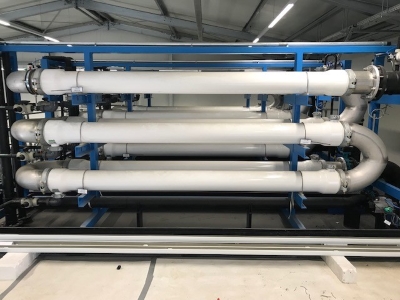
- Company
- Services
- Fields of Expertise
- Publications
- References
- Contact
- EN DE

Leachate is the term used to describe wastewater from landfills or waste recycling plants. Leachate is often heavily contaminated with organic and inorganic pollutants, so precipitation and surface water that has entered the landfill body is collected under the landfill body to prevent contamination of the soil and groundwater.
 Treatment of leachate is essential and required by law before it is discharged into a receiving water body (direct discharge) or sent to a municipal wastewater treatment plant (indirect discharge). The limit values of the pollutant parameters to which the leachate must be purified for direct or indirect discharge are specified in Annex 51 of the German Wastewater Directive (AbwV).
Treatment of leachate is essential and required by law before it is discharged into a receiving water body (direct discharge) or sent to a municipal wastewater treatment plant (indirect discharge). The limit values of the pollutant parameters to which the leachate must be purified for direct or indirect discharge are specified in Annex 51 of the German Wastewater Directive (AbwV).
There are numerous treatment processes for wastewater treatment, which are often used in combination with each other for optimized purification performance.
Often, especially when the degradation of nitrogen compounds is desired, a leachate treatment plant consists of a biological treatment stage with downstream filtration for sludge separation and an activated carbon adsorption stage for the reduction of substances that are difficult to biodegrade. In the biological stage, biodegradable carbon and nitrogen compounds are broken down by bacteria by means of nitrification and denitrification. The removal of nitrogen reduces the eutrophication potential. The typical next treatment step is then a mechanical separation of activated sludge and biologically pre-cleaned leachate by filtration. The state of the art here is the use of ultrafiltration systems.
 A large proportion of the separated biomass is returned to the biological stage, while a smaller proportion is removed from the system as excess sludge and sent to subsequent sludge treatment/sludge dewatering. The solids-free, biologically pre-treated leachate is then purified to the required limits in the next treatment step, the activated carbon adsorption stage. The activated carbon adsorbs the substances that are difficult to degrade via biological processes, such as difficult-to-degrade COD, AOX, PAH/BTX and hydrocarbons.
A large proportion of the separated biomass is returned to the biological stage, while a smaller proportion is removed from the system as excess sludge and sent to subsequent sludge treatment/sludge dewatering. The solids-free, biologically pre-treated leachate is then purified to the required limits in the next treatment step, the activated carbon adsorption stage. The activated carbon adsorbs the substances that are difficult to degrade via biological processes, such as difficult-to-degrade COD, AOX, PAH/BTX and hydrocarbons.
In addition to these processes, there are several others, such as reverse osmosis, ozonation, evaporation, precipitation, sedimentation or chemical oxidation, which are used in the process of leachate treatment.
All processes and operating methods have to be individually adapted to the local conditions and boundary conditions in order to find the technically and economically optimal concept for the respective task through detailed planning. For the evaluation of different leachate treatment concepts and the final selection of the concept to be implemented, in most cases other factors such as space conditions, existing plant components or even references have to be considered in addition to the technical/economic criteria.